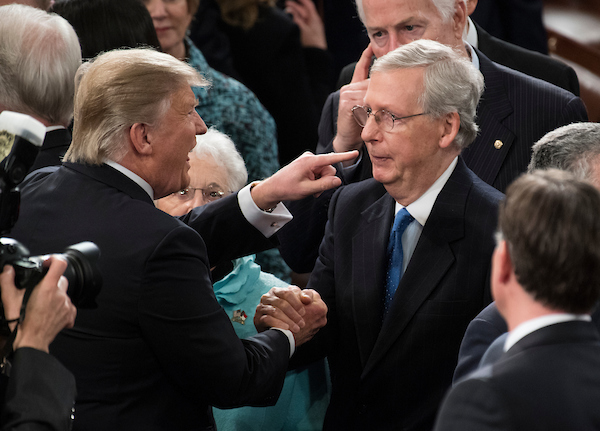The State of the Union is … perhaps outdated?
The latest fight over the address provides a time for evaluation

ANALYSIS — Think of the State of the Union address as the appendix of American government.
It’s been there a while. No one is quite sure exactly what it does. When it’s gone, no one notices.
The standoff over the partial government shutdown, and particularly how it led to a fight between President Donald Trump and Speaker Nancy Pelosi over the timing, delivery and venue of the State of the Union, produced one unexpected side benefit: a refresher civics course.
The speaker can’t, for instance, cancel a State of the Union. The president can’t show up to deliver one whenever he feels like it.
It’s all there in the Constitution, Article II, Section 3: “He shall from time to time give to the Congress Information of the State of the Union, and recommend to their Consideration of such Measures as he shall judge necessary and expedient.”
That’s all, folks.
Setting the time and venue for a joint session of Congress to hear the president deliver the speech requires passing a concurrent resolution. This is where Pelosi flexed her authority, and Trump backed down. Separation of powers for all to see. (And of course, it’s back on now, with the speaker, now that the shutdown is over, on Monday inviting the president to deliver the SOTU speech on Feb. 5.)
Not wanting to let a teachable moment go to waste, it might be worth asking if the State of the Union in its current form is the best we can hope for.
Leaving aside the Trump-Pelosi kerfuffle, is the practice of a president addressing a joint session of Congress during prime-time television, with canned applause lines, human props and hugs and grins aplenty, the ideal way to put on this show?
We are, after all, getting information from a vividly decentralized spectrum.
Last year, an estimated 45.6 million people watched Trump’s SOTU live on Jan. 30, across 12 networks, according to ratings lodestar Nielsen. That roughly tracked with Trump’s first kinda-sorta SOTU in 2017 (technically a joint address to Congress), which clocked in at 47.4 million viewers.
Compare that to Bill Clinton’s first kinda-sorta SOTU on Feb. 17, 1993: 66.9 million over four networks.
One thing Nielsen numbers show is the longer a president is around, the more “meh” the audience.
By 2000, Clinton was at 31.5 million viewers. George W. Bush and Barack Obama saw similar trajectories.
Although it may seem like the State of the Union is set in stone, the president’s tradition of traipsing to the Capitol dates to Woodrow Wilson in 1913, with notable exceptions. (More on that later.) Even Wilson skipped it in 1919 and 1920 due to ill health, and “from time to time” his successors have ditched the speech and just sent written messages.
Jimmy Carter was the last one to do that, in 1981, after he lost to Ronald Reagan. In the years they left office, Carter’s successors bailed altogether, providing neither oral nor written messages.
For die-hard fans of hearing something, anything around the beginning of those years, new presidents have addressed joint sessions, for a variety of stated reasons, either to talk about “economic recovery” (Reagan) or a “budget message” (Bush). In other words, kinda-sorta SOTUs.
Dating back to the early republic, George Washington and John Adams delivered SOTUs in person. Thomas Jefferson passed, sending a written message. Other presidents followed his lead. Until Wilson. Sometimes.
It underscores that the State of the Union has been remarkably stable, except, of course, when it isn’t. And when it isn’t, people rarely make a fuss, if they notice at all.
“My slogan would be mend it, don’t end it,” says Jason Grumet, president of the Bipartisan Policy Center. He believes the president coming to “the people’s House” fulfills an important role in a healthy democracy.
But tweaks? For sure.
For one, “no interruptions,” Grumet says. “It’s become like one of those whack-a-mole games,” with each side standing up, clapping or sitting on their hands. “Let the president give his speech.”
Also: No more acknowledged guests. “Both parties have started to use people as emotional pawns in ways that are not graceful,” Grumet says.
Finally, he says, leave the Joints Chiefs of Staff and the Supreme Court home, taking them out of the political limelight.
Grumet also says Trump deserves credit for not pressing for an alternative venue, seeming to realize “there’s something diminished about the president giving it at a rally or some other partisan venue.”
So, can the clapping, punt on the props, remember it’s about the State of the Union, not the State of the Party?
Why not? We can always fall back to what’s familiar.
How’s that working out, by the way?





